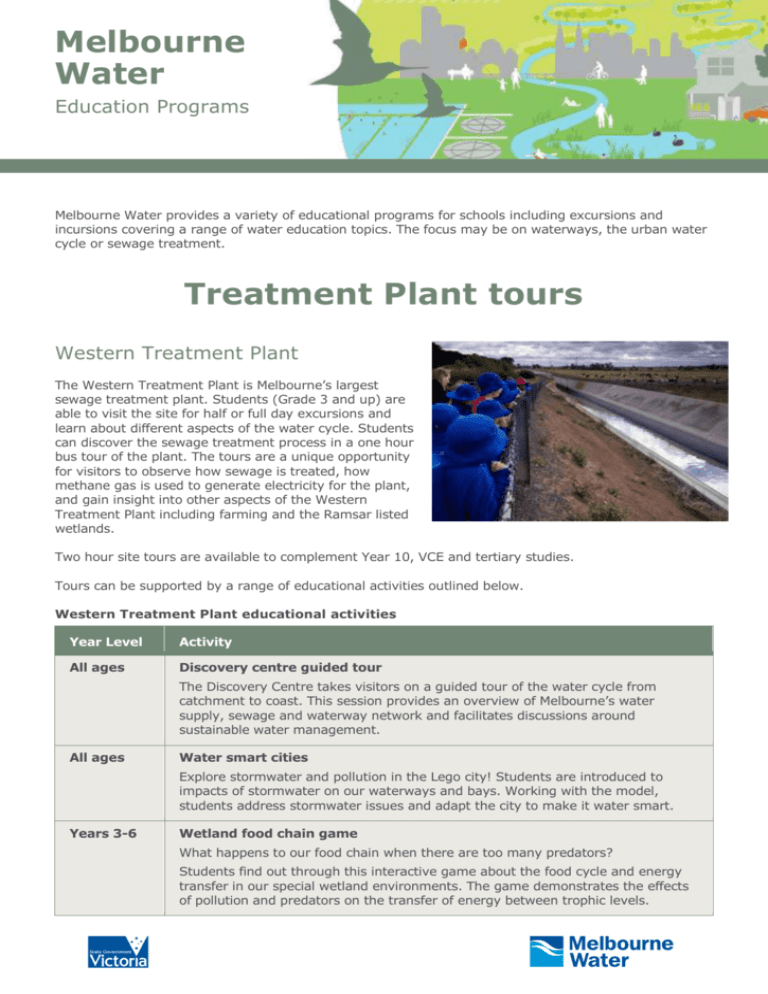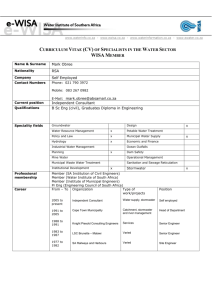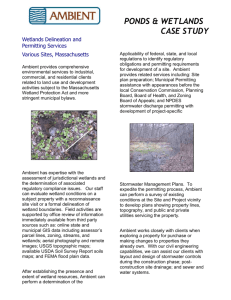Melbourne Water Education Programs
advertisement

Melbourne Water Education Programs Melbourne Water provides a variety of educational programs for schools including excursions and incursions covering a range of water education topics. The focus may be on waterways, the urban water cycle or sewage treatment. Treatment Plant tours Western Treatment Plant The Western Treatment Plant is Melbourne’s largest sewage treatment plant. Students (Grade 3 and up) are able to visit the site for half or full day excursions and learn about different aspects of the water cycle. Students can discover the sewage treatment process in a one hour bus tour of the plant. The tours are a unique opportunity for visitors to observe how sewage is treated, how methane gas is used to generate electricity for the plant, and gain insight into other aspects of the Western Treatment Plant including farming and the Ramsar listed wetlands. Two hour site tours are available to complement Year 10, VCE and tertiary studies. Tours can be supported by a range of educational activities outlined below. Western Treatment Plant educational activities Year Level Activity All ages Discovery centre guided tour The Discovery Centre takes visitors on a guided tour of the water cycle from catchment to coast. This session provides an overview of Melbourne’s water supply, sewage and waterway network and facilitates discussions around sustainable water management. All ages Water smart cities Explore stormwater and pollution in the Lego city! Students are introduced to impacts of stormwater on our waterways and bays. Working with the model, students address stormwater issues and adapt the city to make it water smart. Years 3-6 Wetland food chain game What happens to our food chain when there are too many predators? Students find out through this interactive game about the food cycle and energy transfer in our special wetland environments. The game demonstrates the effects of pollution and predators on the transfer of energy between trophic levels. Year Level Activity Years 3-6 Stormwater story How does litter and rubbish end up in our rivers and creeks? Students actively take on roles in a journey down the Yarra River from catchment to coast, to see how humans impact on the quality of stormwater. Students discuss different actions that can be taken and the impact on river health. Years 5-9 What goes where? Where should household wastes go? What can go onto the compost heap, in the recycling bin or the rubbish bin? What should go into the sewerage and stormwater systems? In this interactive game, student teams debate the answer to these questions. Years 5-9 Living in a catchment What is a catchment? What impacts do we have on the catchment we live in? Students construct a giant jigsaw puzzle in teams to study the factors that affect water quality. This session facilitates discussion on land use and water quality. Years 5-9 Water recycling model How can we use less drinking water? This session investigates different sources of water including groundwater, potable water and recycled water. Students discuss what activities can utilise different sources of water and how we can use less potable water. Years 7-9 Micro-organisms at work How do micro-organisms help to treat wastewater? Students explore the different types and functions of micro-organisms that can be found throughout the treatment process. Costs Group type Max. group size Length Cost (per student) Minimum fee Years 3-9 90 1 hour $3.90 $180 Years 10-12 90 2 hours $7.80 $180 TAFE, tertiary and community 30 1 hour $7.80 $210 2 hours $11.70 Each educational activity that is additional to a tour is $3.90 per student, per activity. A one hour tour and one educational activity is $7.80 per student, a one hour tour and two educational activities is $11.70 per student. Bookings Email tours@melbournewater.com.au or phone 8734 4264. Website: http://melbournewater.com.au/getinvolved/education/programs/WTPtours/Pages/Visit-theWestern-Treatment-Plant.aspx July, 2014 Melbourne Water Education Programs | 2 Eastern Treatment Plant The Eastern Treatment Plant is Melbourne’s second biggest sewage treatment facility, treating around 40% of Melbourne’s waste water. A two hour session that includes an introductory presentation and a walking tour of the site is available to secondary and tertiary groups. During their tour of the plant, visitors learn about the different stages of water treatment including sedimentation, ammonia removal and disinfection. The tour also provides commentary on the use of biogas for energy generation, the recent tertiary treatment upgrade and recycled water. These tours can also be combined with a trip to the EdithvaleSeaford Wetland Education Centre (ESWEC). The two-hour tours must be pre-booked, and can be arranged at the following days and times: Mondays, Tuesdays, Thursdays and Fridays 10am–12pm or 12.30pm–2.30pm Costs Group type Max. group size Cost (per student) Minimum fee Years 7-12 50 $7.80 $180 TAFE and tertiary groups 45 $8.40 $210 Combined tour with ESWEC visit 35* (at ESWEC) $13.00 $180 Please note tours are not suitable for primary school students. *ESWEC maximum number includes students, teachers / other supervising adults. Bookings Email tours@melbournewater.com.au or phone 8734 4264 to speak to the Education team. Website: http://melbournewater.com.au/getinvolved/education/programs/ETPtours/Pages/VisitEastern-Treatment-Plant.aspx July, 2014 Melbourne Water Education Programs | 3 Edithvale-Seaford Wetlands Education Centre Completed at the end of 2011, the Edithvale-Seaford Wetlands Education Centre has been designed with sustainability in mind and built to meet strict environmental standards. The centre offers educational activities closely linked with Victorian Essential Learning Standards (VELS) and the Australian curriculum for up to 35 students at one time. During a two hour session with one of our experienced educators, students learn about the value and importance of the wetland to the environment and to the past and present community. They can also observe the wildlife in a natural habitat. Edithvale-Seaford Wetlands Education Centre education sessions Year Level Activity Prep Feeling alive! – Living and non-living components of the wetland Students observe the wetland, taking notice of the living and non-living components. They compare what they see to the school ground environment. They use a variety of sources to explore and identify what is living and non-living. Bird dance – Observing the wetland birds Students spend time observing the behaviours of the birds found at the wetlands. They consider what makes this area and other natural areas special for the birdlife. They begin to understand the impact they can have on the wetland environment and the birds. Grades 1 and 2 The cycle of life – Lifecycles Students use the wetlands to explore the lifecycle. Using items collected from the wetlands students identify the living species it relates to and where that item fits in that species' lifecycle. Our water world – The whole water cycle Students learn about the importance of water to the wetlands and the role of the wetlands in filtering the water and purifying it before it enters our bay. They explore the stormwater interactive model and watch the process of water from catchment to the bay. Grades 3 and 4 Going batty! – Surveying bats Students are introduced to the bats that live at the wetland and the ways in which they are surveyed. Students hear the call of bats recorded locally before participating in a series of activities focussing on how mother bats find their pups in the crowded nursery caves. Why live here? – What makes this location a liveable environment Students learn about the wetland and consider why this area is a good place to live? They look at different scenarios of people who use the wetland and animals that rely on the wetland. July, 2014 Melbourne Water Education Programs | 4 Year Level Activity Grades 5 and 6 Vegetation investigation – Discovering wetland plants Students begin to understand classification as they group wetland plant samples according to their similarities. They create a herbarium sample of a wetland plant to take home with them. Pardon me, while I change in front of you – Wetland history Students model changes in the wetland over time as they learn about the history of the wetlands since the local indigenous tribes to European settlement of the area and more recent times. Students identify the value of the wetland over time and how it has changed. Who’s hungry? – Food chain and food webs Students explore the natural process of the food chain using creatures of the wetland. They experience the food chain by playing a game and apply their learning by creating their own food chain of a wetland creature. Secondary Guided viewing platform walk Students take a short walk with our educators to wetland viewing points and learn about aspects of wetland, depending on their area of study. This may include: All local biodiversity land use and liveability outdoor education drainage and flood protection Stormwater interactive model (SIM) – Stormwater in our waterways The stormwater interactive model is an educational model of an urban catchment that demonstrates the impact of stormwater on our rivers, creeks and bays. Self-guided viewing platform walk Self-guided walks are available for all visitors as an additional independent activity to your centre visit. Please advise us in advance if you would like to make use of bird identification or scavenger hunt resources. Costs Group type Max. group size Cost (per student) Primary, secondary or tertiary students 35* $3.90 ESWEC combined with an Eastern Treatment Plant tour (secondary/tertiary) 35* (50 at ETP) $13.00 *ESWEC maximum number includes students, teachers / other supervising adults. Bookings Email tours@melbournewater.com.au or phone 8734 4264 to speak to the Education team. Website: http://melbournewater.com.au/getinvolved/education/programs/eswdc/Pages/EdithvaleSeaford-Wetland-Discovery-Centre.aspx July, 2014 Melbourne Water Education Programs | 5 Melbourne Water Incursions An experienced Education Officer can visit your school to deliver Victorian Essential Learning Standards (VELS) and Australian curriculum linked sessions that focus on the diversity of our rivers and creeks, water quality and the natural and urban water cycles. Each incursion session is run by one of our experienced Education Officers and goes for 45 minutes. The maximum group size per session is 30 students. A description of the sessions and the relevant AusVELS level is listed below. Incursion sessions Year Level Activity Foundation – Level 2 Growing and Changing Introducing students to frogs and their lifecycles. Students learn about our local frogs and the different sounds they make. Meet the waterbugs Students study aquatic macro-invertebrates (waterbugs) to see what they look like and how they move. Students sort waterbugs according to common features and characteristics including colour, size, shape and movement. Water cycle puzzles An activity to introduce students to the natural water cycle. Students investigate where water comes from and how it ends up in our waterways and bays. Land use in a catchment Introducing students to the concept of a catchment. Using the ‘Water Smart City’ model, students investigate what lives in a catchment and the many ways we use water in our catchment. Stormwater story Students participate in a catchment story. The session demonstrates the connection between the stormwater system, the health of river and marine environments, and actions to reduce environmental impacts. Levels 3 to 4 The life of macro-invertebrates Students explore the structure and function of aquatic macro-invertebrates in their juvenile and adult forms. Students also discuss how these animals are an important indicator of water quality. Turbidity and erosion This session investigates the causes of increased turbidity and possible effects on aquatic life. This session is an introduction to testing the less visible forms of pollution affecting a waterway. July, 2014 Melbourne Water Education Programs | 6 Year Level Activity Water smart cities Explore stormwater and pollution in the Lego city! Students are introduced to impacts of stormwater on our waterways and bays. Working with the model, students address stormwater issues and adapt the city to make it water smart. Stormwater story Students participate in a catchment story. The session demonstrates the connection between the stormwater system, the health of river and marine environments, and actions to reduce environmental impacts. Levels 5 to 6 Waterbugs, how they get their oxygen Students learn about macro-invertebrates unique adaptations. Students discover the structure and function of various macroinvertebrate breathing apparatuses, while sorting and identifying a live sample. Students also discuss how these animals are an important indicator of water quality. Increased nutrients in the waterway Explores the impact of increased nutrients on our waterways. Students link phosphates to grey water, and the impact of stormwater on our waterways. Students assess the quality of a water sample through testing for phosphate. Water smart cities Explore stormwater and pollution in the Lego city! Students are introduced to impacts of stormwater on our waterways and bays. Working with the model, students address stormwater issues and adapt the city to make it water smart. Stormwater story Students participate in a catchment story. The session demonstrates the connection between the stormwater system, the health of river and marine environments, and actions to reduce environmental impacts. Levels 7 to 8 Classifying macro-invertebrates Students will classify macro-invertebrates by their observable structural features. Students will learn how to use a dichotomous key to identify aquatic organisms. Turbidity and electrical conductivity Exploring the effect of turbidity and electrical conductivity (a measure of salinity) on water quality in our rivers and creeks. Student use scientific equipment to measure these two water quality parameters. Water smart cities Explore stormwater and pollution in the Lego city! Students are introduced to impacts of stormwater on our waterways and bays. Working with the model, students address stormwater issues and adapt the city to make it water smart. Levels 9 to 10 Local waterway field trip (excursion) Prepare and guide students in undertaking a habitat assessments. Activities may include conducting a transect survey, water quality testing and/or the use a macro-invertebrate sample as an indicator of water quality. Other activities by enquiry. July, 2014 Melbourne Water Education Programs | 7 Costs Incursion type Max. group size Cost Half day (one – three sessions) 30 per session $500.00 Full day (four – six sessions) 30 per session $750.00 Bookings Email education@melbournewater.com.au or phone 8734 4264 to speak to the Education team. Website: http://melbournewater.com.au/getinvolved/education/programs/Pages/River-healthincursions.aspx July, 2014 Melbourne Water Education Programs | 8







